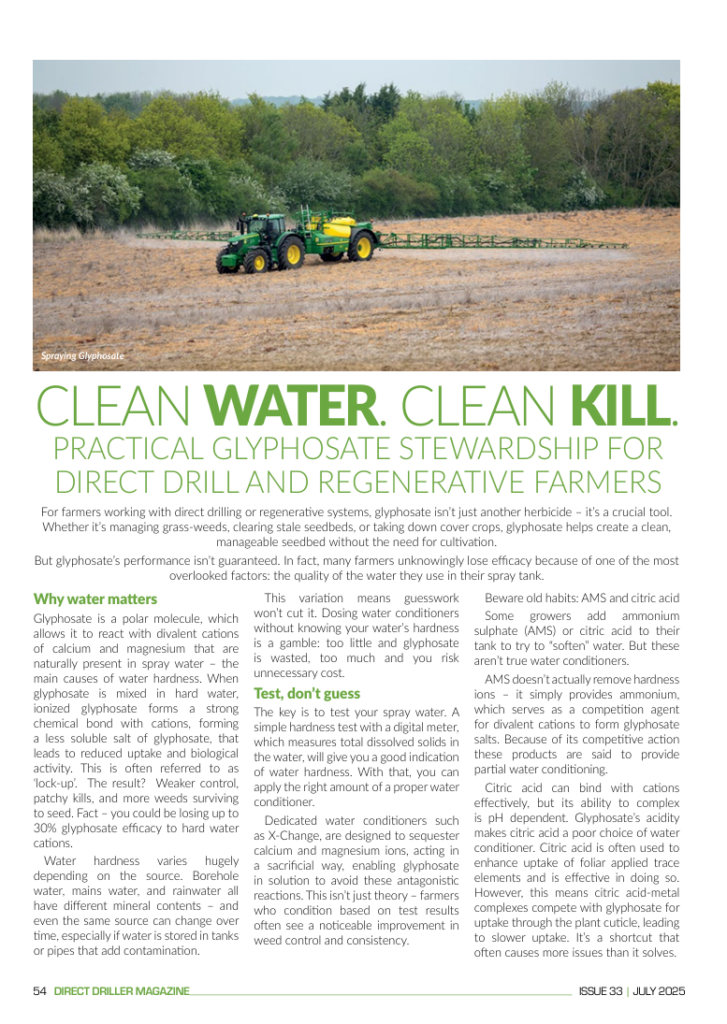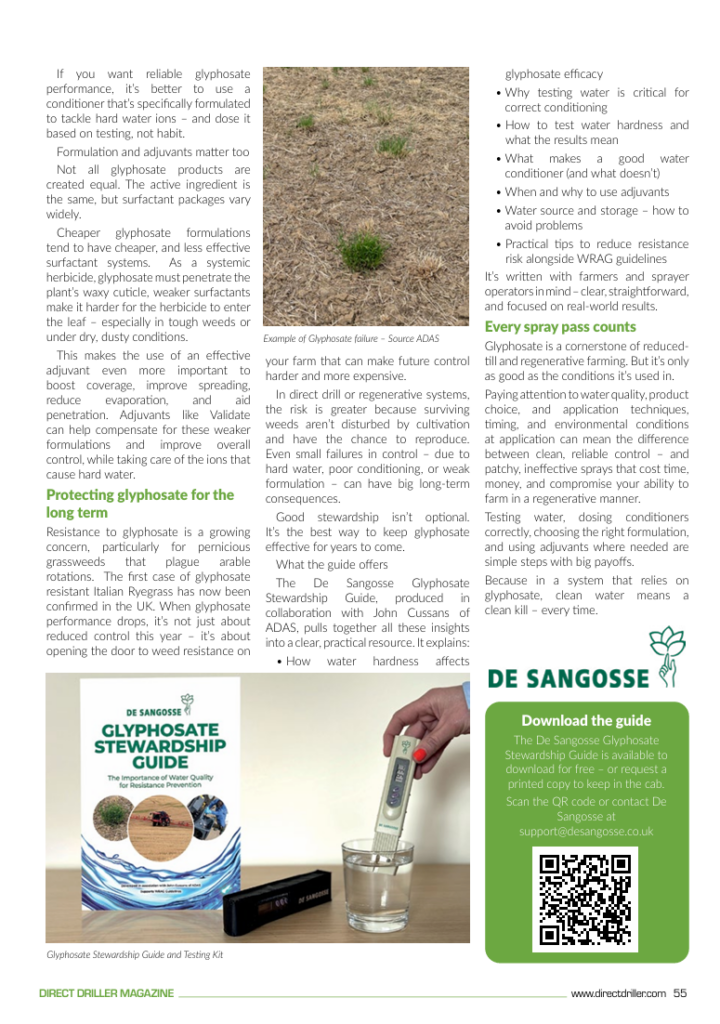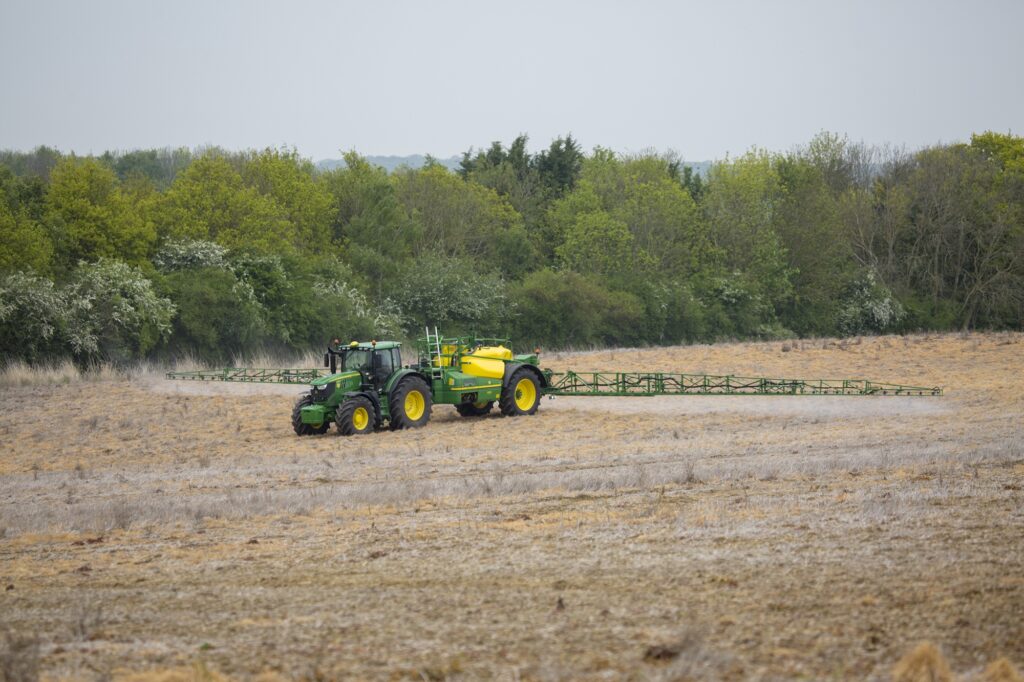Practical glyphosate stewardship for direct drill and regenerative farmers
For farmers working with direct drilling or regenerative systems, glyphosate isn’t just another herbicide – it’s a crucial tool. Whether it’s managing grass-weeds, clearing stale seedbeds, or taking down cover crops, glyphosate helps create a clean, manageable seedbed without the need for cultivation.
But glyphosate’s performance isn’t guaranteed. In fact, many farmers unknowingly lose efficacy because of one of the most overlooked factors: the quality of the water they use in their spray tank.
Why water matters
Glyphosate is a polar molecule, which allows it to react with divalent cations of calcium and magnesium that are naturally present in spray water – the main causes of water hardness. When glyphosate is mixed in hard water, ionized glyphosate forms a strong chemical bond with cations, forming a less soluble salt of glyphosate, that leads to reduced uptake and biological activity. This is often referred to as ‘lock-up’. The result? Weaker control, patchy kills, and more weeds surviving to seed. Fact – you could be losing up to 30% glyphosate efficacy to hard water cations.
Water hardness varies hugely depending on the source. Borehole water, mains water, and rainwater all have different mineral contents – and even the same source can change over time, especially if water is stored in tanks or pipes that add contamination.
This variation means guesswork won’t cut it. Dosing water conditioners without knowing your water’s hardness is a gamble: too little and glyphosate is wasted, too much and you risk unnecessary cost.
Test, don’t guess
The key is to test your spray water. A simple hardness test with a digital meter, which measures total dissolved solids in the water, will give you a good indication of water hardness. With that, you can apply the right amount of a proper water conditioner.
Dedicated water conditioners such as X-Change, are designed to sequester calcium and magnesium ions, acting in a sacrificial way, enabling glyphosate in solution to avoid these antagonistic reactions. This isn’t just theory – farmers who condition based on test results often see a noticeable improvement in weed control and consistency.
Beware old habits: AMS and citric acid
Some growers add ammonium sulphate (AMS) or citric acid to their tank to try to “soften” water. But these aren’t true water conditioners.
AMS doesn’t actually remove hardness ions – it simply provides ammonium, which serves as a competition agent for divalent cations to form glyphosate salts. Because of its competitive action these products are said to provide partial water conditioning.
Citric acid can bind with cations effectively, but its ability to complex is pH dependent. Glyphosate’s acidity makes citric acid a poor choice of water conditioner. Citric acid is often used to enhance uptake of foliar applied trace elements and is effective in doing so. However, this means citric acid-metal complexes compete with glyphosate for uptake through the plant cuticle, leading to slower uptake. It’s a shortcut that often causes more issues than it solves.
If you want reliable glyphosate performance, it’s better to use a conditioner that’s specifically formulated to tackle hard water ions – and dose it based on testing, not habit.
Formulation and adjuvants matter too
Not all glyphosate products are created equal. The active ingredient is the same, but surfactant packages vary widely.
Cheaper glyphosate formulations tend to have cheaper, and less effective surfactant systems. As a systemic herbicide, glyphosate must penetrate the plant’s waxy cuticle, weaker surfactants make it harder for the herbicide to enter the leaf – especially in tough weeds or under dry, dusty conditions.
This makes the use of an effective adjuvant even more important to boost coverage, improve spreading, reduce evaporation, and aid penetration. Adjuvants like Validate can help compensate for these weaker formulations and improve overall control, while taking care of the ions that cause hard water.
Protecting glyphosate for the long term

Resistance to glyphosate is a growing concern, particularly for pernicious grassweeds that plague arable rotations. The first case of glyphosate resistant Italian Ryegrass has now been confirmed in the UK. When glyphosate performance drops, it’s not just about reduced control this year – it’s about opening the door to weed resistance on your farm that can make future control harder and more expensive.
In direct drill or regenerative systems, the risk is greater because surviving weeds aren’t disturbed by cultivation and have the chance to reproduce. Even small failures in control – due to hard water, poor conditioning, or weak formulation – can have big long-term consequences.
Good stewardship isn’t optional. It’s the best way to keep glyphosate effective for years to come.
What the guide offers
The De Sangosse Glyphosate Stewardship Guide, produced in collaboration with John Cussans of ADAS, pulls together all these insights into a clear, practical resource. It explains:
- How water hardness affects glyphosate efficacy
- Why testing water is critical for correct conditioning
- How to test water hardness and what the results mean
- What makes a good water conditioner (and what doesn’t)
- When and why to use adjuvants
- Water source and storage – how to avoid problems
- Practical tips to reduce resistance risk alongside WRAG guidelines
It’s written with farmers and sprayer operators in mind – clear, straightforward, and focused on real-world results.

Every spray pass counts
Glyphosate is a cornerstone of reduced-till and regenerative farming. But it’s only as good as the conditions it’s used in.
Paying attention to water quality, product choice, and application techniques, timing, and environmental conditions at application can mean the difference between clean, reliable control – and patchy, ineffective sprays that cost time, money, and compromise your ability to farm in a regenerative manner.
Testing water, dosing conditioners correctly, choosing the right formulation, and using adjuvants where needed are simple steps with big payoffs.
Because in a system that relies on glyphosate, clean water means a clean kill – every time.
Download the guide
The De Sangosse Glyphosate Stewardship Guide is available to download for free – or request a printed copy to keep in the cab.
click the link or contact De Sangosse at support@desangosse.co.uk
https://www.desangosse.co/asset-view/?id=145&salt=302032424


